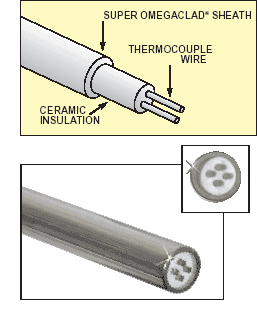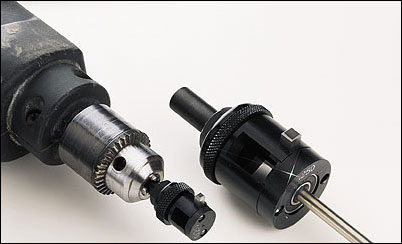APPLICATIONS
 | Heat Treating Metal Parts
| |  |
 | Gas or Oil Fired Furnaces
|
 | Fuel Fired Heat Exchangers
|
 | Ceramic Materials Firing
|
 | Powder Metal Sintering
|
 | Steel Carburizing Furnaces
|
 | Vacuum/Atmosphere Melting & Annealing
|
 | Solid Waste Incinerators
|
 | Heat Process Fluidized Beds
|
 | R&D Tube or Box Furnaces
|
The metallic sheath on the outside of an OMEGACLAD® probe is used to protect the internal thermocouple
wires from chemically active atmospheres. In some cases, even hot air can damage thermocouple
wires and cause them to permanently lose calibration. Selection of the best type of metal
sheath to employ is based on our customers’ intended use, the industry in which they work, and the
country where they are located. For instance, the most common OMEGA® metal sheaths are 304
stainless steel and Inconel 600. These are accepted in most industries, including food
processing. Stainless steel 304 is a common alloy, readily available and low in the cost of both materials and
manufacture. Some industries, however, such as petroleum, medical, nuclear, aircraft, and power
generation, have their own standards and may require more complicated and expensive alloys.
Listed below are the sheath materials that OMEGA Engineering uses to make OMEGACLAD®. Any materials
not on this list must be customized; direct inquiries will have to made to
OMEGA South for pricing, availability and size limitations.
304 Stainless Steel
OMEGA Engineering uses a lowcarbon version of 304 stainless, called 304L, mainly because it is
easier to weld. In general, it is interchangeable with plain 304.
Applications:
Food & beverage processing
Chemical processing
Dairy
Hospital equipment
Pharmaceutical equipment
Nuclear reactor equipment
Containers for mild corrosives
Temperature limitations: up to 1,600°F for cyclic processes.
Use Inconel 600 for extended use around or above 1,650°F
Inconel 600
This high nickel and chromium content alloy is more expensive than most stainless steels. It is good
for extended use at high temperatures and resists corrosion
by most simple acids and very pure water.
Applications:
Furnace components
Chemical & food processing
Nuclear power generation
Caustic chemicals
Temperature limitations: up to 2,100°F
OMEGA SUPERCLAD™
 This alloy has excellent resistance to air at high temperatures. It has an aluminum oxide layer on the surface
that prevents further oxidation. This oxidation resistance allows thermocouple probes to operate for
extended periods before EMF drift “decalibrates” the thermocouple. It is also popular for its resistance to
hydrogen gas and its high strength at high temperatures. Because of form limitations and difficulty in
processing, it is more expensive than any of the alloys discussed above.
This alloy has excellent resistance to air at high temperatures. It has an aluminum oxide layer on the surface
that prevents further oxidation. This oxidation resistance allows thermocouple probes to operate for
extended periods before EMF drift “decalibrates” the thermocouple. It is also popular for its resistance to
hydrogen gas and its high strength at high temperatures. Because of form limitations and difficulty in
processing, it is more expensive than any of the alloys discussed above.
Applications:
Furnace components
Gas turbine industry
Catalytic converter components
Aerospace jet & rocket engines
Refractory anchors
Waste incinerators
Temperature limitations: Approx. 2,220°F . Also is acceptable in heated hydrogen, ~ 2000°F
310 Stainless Steel
This is commonly used at higher temperatures because it resists scaling up to 1,900°F. It is stronger
and resists air attack better than 304SS at these higher temperatures. Also good in fossil
fuel gases at elevated temperatures.
Applications: (Higher temperatures)
Air heaters
Baking equipment
Chemical processing equipment
Furnace parts
Heat exchangers and electric
power equipment (that does not
come in contact with sulphur)
Petroleum refining
Temperature limitations: up to 1,900°F
316 (& 316L) Stainless Steel
Better corrosion resistance to most chemicals, salts, and acids than
most stainless steels due to the addition of molybdenum. It has good
resistance to sulphur- or chlorinebearing liquids.
Applications:
Marine trim exteriors
Chemical and food processing
Petroleum refining equipment
Pharmaceutical equipment
Paper & pulp
Textile finishing
Temperature limitations: up to 1,600°F continuously in air or
in cyclic corrosive environments, slightly higher in air.
321 Stainless Steel
This alloy is similar to 304 stainless except that it incorporates titanium.
It is intended for welded components that are exposed to
high temperatures, and is especially well suited to long exposure to air
and combustion atmospheres of around 800°F.
Applications:
Aircraft exhausts & manifolds
Jet engine parts
Stack liners
Welded equipment
Chemical processing equipment
Temperature limitations: up to 1,600°F
Hastelloy-X
This alloy is expensive due to the addition of iron, chromium and
molybdenum. It has very good high temperature strength and good
oxidation resistance. It is a relatively old alloy, less costly and with better
performance than some newer alloys.
Applications:
Gas Turbines for power
generation
Aerospace applications
Industrial furnaces
Boiler & pressure vessels
Temperature limitations: up to 2,150°F

Thermocouple Wire Stripper for OMEGACLAD® wire.
See PST Series Strippers in Section H.
|









